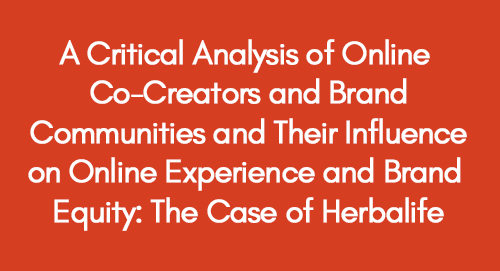
Fashion
July 12, 2022
Assessing the Water Quality and Mineral Footprint in Tano River Basin Using Bio_Optics Modeling and Remote Sensing Techniques
July 12, 2022In the digital symphony of Herbalife's narrative, we dissect the harmonious interplay between online co-creators and brand communities, revealing the orchestrators of a transformative online experience and architects of fortified brand equity.
Outline
- Introduction
- Problem Statement
- Research Questions
- Research Objectives
- Key Concepts
- Research Design
- Data Collection Method
- Conclusion
- Reference List
In the digital era, consumer-brand dynamics have transcended traditional norms, paving the way for co-creation and brand communities. This paradigm shift is particularly pronounced in the context of Herbalife, a global nutrition company. In this blog, we intricately analyze the influence of online co-creators and brand communities within Herbalife's digital landscape, probing their critical role in shaping the online experience and, by extension, moulding the brand's overarching equity.
Learn More About the Impacts of Online Co-Creators and Brand Communities
Explore More About the Impacts of Online Co-Creators and Brand Communities
Herbalife's online presence is a dynamic canvas where consumers actively transition into co-creators, contributing to a narrative beyond typical marketing strategies. Establishing brand communities further amplifies this engagement, fostering a sense of shared purpose and connection. Through a critical lens, we examine how these digital elements collaboratively redefine the consumer-brand relationship, spotlighting their instrumental role in sculpting the distinctive online experience and bolstering Herbalife's brand equity in a competitive marketplace.
Introduction
According to Veloutsou and Delgado-Ballester (2018), a brand is a dynamic collection of tangible and human-like attributes communicating a product's advantages through symbols, setting it apart in a competitive landscape. Brands are powerful social catalysts, providing meaning and identity to consumer choices, allowing self-expression and societal status conveyance. Growing consumer interest indicates a preference for co-creating experiences, reflecting a shift from functional to experiential value, influencing behaviour and engagement (Delgado-Ballester and Fernández-Sabiote, 2015). This transition underscores the pivotal role of experiences in shaping consumer perceptions and responses to brands (Rialti et al., 2018).
In response to McKinsey's 2030 Consumer Sector trends, companies are urged to thoroughly understand consumer desires and preferences for informed product and brand evolution. As emphasised by McKinsey, social media's impact on purchase decisions underscores the evolving nature of consumer engagement. Online brand communities (OBCs) have surged as significant contributors to digital conversations, providing individuals a platform to express identities through active engagement. Black and Veloutsou (2017) highlight this avenue for co-creating experiences. Despite existing research on co-creation within online communities, the relationship between co-created experiences and brand equity remains underexplored. This study delves into the role of online content curators and brand communities as advocates for Herbal Life South Africa, assessing their influence on brand experience with Keller's (1993) Customer-based Brand Equity Model. The exploration is conducted on Instagram.
Rationale and Relevance
The rapid evolution of digital revolutions and online platform engagements is reshaping the landscape of brand management and consumer behaviour. Babin and Hulland (2019) highlight that a brand's understanding of consumer online behaviour in content curation is instrumental in uncovering improved metrics for engagement, discerning perceived brand associations, and identifying strategic partnership opportunities.
In marketing, there is a notable shift from influencers to creators. Unlike influencers, creators are characterized by a genuine passion for and commitment to curating content that adds value to their communities, as Bakhtiari (2020) emphasised. Consequently, this study will thoroughly analyse various online curated content, focusing on Herbalife as a significant brand in the Health and Wellness sector.
Problem Statement
In today's media-centric culture, brands no longer have the authority to control the narrative about them online and shape consumers' experiences. As noted by Veloutsou and Guzmán (2017), organizations are shifting from traditional, centralized brand building initiated by the company to a more interactive and participatory approach known as conversational branding, involving contributions from various sources.
As highlighted by [Author] in [Year], the absence of active communication and social media facilitation has empowered numerous individuals to express their opinions and sentiments about brands, reaching a broad audience. In this context, Herbalife emerges as a prominent player in the health and wellness sector (Research and Markets, 2020). Therefore, this study aims to investigate the impact of these co-created experiences on Herbalife's brand equity.
Purpose Statement
This study examines the online content curation of Herbalife South Africa and its correlation with brand experience, particularly exploring the potential influence of online co-creation. This paper aims to unveil the connection to brand equity by analysing online content curators and Herbalife brand communities.
Research Questions
What impact does online content co-creation have on the brand equity of Herbalife South Africa?
How do online consumers perceive and engage with Herbalife through content co-created in the digital space?
To what extent does co-creation serve as a competitive advantage and effective online strategy for Herbalife compared to other brands in the same category?
What significance does co-creation within brand communities hold for brand management in the rapidly evolving digital era?
Research Objectives
Assessing the impact of online content co-creation on the brand equity of Herbalife South Africa.
Examining the online consumer experience with Herbalife through the lens of co-created content.
Unravelling the strategic significance of content co-creation online and its potential to confer a competitive edge to Herbalife within its category of brands.
Investigating co-creation's role in shaping brand communities and its implications for effective brand management in the swiftly evolving digital landscape.
Key Concepts
Content curators
Co-creation
Online Brand Communities (OBC)
Brand Experiences
Brand Equity
Key Theories and Literature Identified Content Curators
Online curators function as endorsers and promoters of content, as indicated by Villi et al. (2012).
Consumer curators act as endorsements in their interactions with audiences, encouraging others to engage with the same curated content and inspire further curation using similar pieces, as explained by Babin and Hulland (2019).

Co-Creation
Consumers have transitioned from passive spectators to active contributors in shaping a brand, influencing its functional attributes, and determining its significance. There is a growing consumer inclination to actively contribute and engage in the continuous co-creation of their preferred brands.

Online Brand Communities
An online brand community (OBC) unfolds in a virtual environment where members interact digitally. Participants in an OBC express their shared interest in a particular brand and convey their enthusiasm. These virtual social engagements are pivotal in shaping the consumer's connection with the brand. Members establish a profound affinity with the brand and develop notably robust connections with one another. This shared sense of belonging fosters a distinct and exclusive identity, separating users of their brand from those associated with other brands (Brogi, 2014).
Brand Experience
Brand experience encompasses the sensory, emotional, cognitive, and behavioural reactions elicited by stimuli associated with a brand, encompassing elements such as its design, identity, packaging, communications, and environments.

Keller’s Customer-Based Brand Equity Model
According to Keller (1993), brand equity is characterized as the distinctive impact of brand knowledge on consumer reactions to the brand's marketing. Examining the associations and perceptions surrounding Herbalife online, shaped by shared and meaningful co-created experiences through the lens of the CBBE model, will offer valuable insights into understanding and evaluating brand equity.

Research Design
The study will adopt a qualitative research methodology, employing in-depth interviews and content analysis to explore and interpret the nuances of the research questions.
Selected Paradigm
This research study will embrace an interpretive paradigm to gain insights from various perspectives and promote a nuanced understanding of the subject matter.
Population and Sampling
The research will focus on adult male and female social media account users in South Africa who use relevant #Hashtags associated with #HerbalifeNutrition until a satisfactory level of analysis is achieved. Following these specific #Hashtags, we intend to identify content creators for Herbalife.
Sampling: Non-probability purposive sampling has been chosen for its suitability in selecting participants based on specific characteristics. Given the online platform context, this method is well-suited. Its advantage lies in ensuring that each chosen element aligns with the population parameters of this research (Pascoe, 2014:143).
Data Collection Method
Primary and Secondary:
This study will utilise Instagram as a visual tool and platform to explore individual posts, employing anthropological perspectives to examine how users relate to and experience Herbalife.
An unobtrusive qualitative content analysis will be the chosen method. As described by Strydom and Bezuidenhout (2014:191), this approach involves a systematic examination of social artefacts to gain a profound understanding of media texts within their specific contexts. This will enable the researcher to amalgamate data from diverse online subjects.
The content analysis will focus on Instagram Herbalife curators employing #HerbalifeNutrition and related #Hashtags.
Additionally, in-depth interviews will be conducted with the Herbalife South Africa brand and marketing team members. These interviews aim to provide internal insights into brand management and gather perspectives on the online content generated by co-creators and brand community members.
Data analysis
Qualitative coding facilitates comprehensive data analysis by systematically categorizing and interpreting patterns, themes, and insights inherent in the information.
Ethical Considerations
The research will consider Trustworthiness, ensuring the study's findings' reliability, credibility, and validity.
Conclusion
In summary, this research navigates the intricate dynamics of online content curation, brand communities, and their impact on Herbalife South Africa's brand equity. Positioned within co-creation, the study addresses the evolving landscape of consumer-brand relationships, emphasizing the pivotal role of social media platforms in shaping brand interactions.
Motivated by McKinsey's directive to understand consumer desires for informed brand evolution, this research employs qualitative methods, including Instagram content analysis and Herbalife South Africa marketing team insights.
The theoretical framework, encompassing content curation, co-creation, online brand communities, brand experiences, and Keller's Customer-Based Brand Equity Model, provides a robust foundation for exploring the nuanced relationships within the digital space.
By prioritising ethical considerations, this study will deliver nuanced insights into how online co-creation influences brand experience and equity for Herbalife in the South African market. The research aspires to offer valuable perspectives on brand management in the digital age, particularly for health and wellness brands like Herbalife, where understanding the complexities of co-created experiences is essential for maintaining relevance in the dynamic digital landscape.
Reference List
Babin, J. and Hulland, J. (2019), "Exploring online consumer curation as user-generated content: A framework and agenda for future research, with implications for brand management", Spanish Journal of Marketing - ESIC, Vol. 23 No. 3, pp. 325-338. https://doi.org/10.1108/SJME-07-2019-0053 [Accessed 25 April 2020]
Benson-Armer, R., Noble, S. and Thiel, A., 2015. The consumer sector in 2030: Trends and questions to consider. Consumer packaged goods and retail. [Accessed 25 April 2020]
Black, I. and Veloutsou, C. (2017), “Working consumers: co-creation of brand identity, consumer identity, and brand community identity”, Journal of Business Research, Vol. 70, pp. 416-429. [Accessed 22 April 2020]
Chepurna, M. and Rialp Criado, J. (2018), "Identification of barriers to co-create online: the perspectives of customers and companies", Journal of Research in Interactive Marketing, Vol. 12 No. 4, pp. 452-471. https://doi.org/10.1108/JRIM-01-2018-0018 [Accessed 21 April 2020]
Litterio, A., Nantes, E., Larrosa, J. and Gómez, L. (2017), "Marketing and social networks: a criterion for detecting opinion leaders", European Journal of Management and Business Economics, Vol. 26 No. 3, pp. 347-366. https://doi.org/10.1108/EJMBE-10-2017-020
McKinsey & Company. 2015. The Consumer Sector In 2030: Trends And Questions To Consider. [Online] Available at: <https://www.mckinsey.com/industries/consumer-packaged-goods/our-insights/the-consumer-sector-in-2030-trends-and-questions-to-consider> [Accessed 20 April 2020].
Rialto, R., Caliandro, A., Zollo, L. and Ciappei, C. (2018), "Co-creation experiences in social media brand communities: Analyzing the main types of co-created experiences", Spanish Journal of Marketing - ESIC, Vol. 22 No. 2, pp. 122-141. [Accessed 20 April 2020]
Stefano Brogi, Online Brand Communities: A Literature Review, Procedia - Social and Behavioral Sciences, Volume 109, 2014, Pages 385-389, ISSN 1877-0428,
https://doi.org/10.1016/j.sbspro.2013.12.477. [Accessed 20 April 2020]
Tang, T.(Y.)., Fang, E.(E.). and Wang, F. (2014), “Is neutral The effects of neutral user-generated content on product sales”, Journal of Marketing, Vol. 78 No. 4, pp. 41-58. [Accessed 20 April 2020]
Romero, J. and Ruiz-Equihua, D. (2020), "Be a part of it: promoting WOM, eWOM, and content creation through customer identification", Spanish Journal of Marketing - ESIC, Vol. 24 No. 1, pp. 55-72. https://doi.org/10.1108/SJME-11-2019-0092 [Accessed 22 April 2020]
Veloutsou, C. and Delgado-Ballester, E. (2018), "New challenges in brand management", Spanish Journal of Marketing - ESIC, Vol. 22 No. 3, pp. 254-271. https://doi.org/10.1108/SJME-12-2018-036 [Accessed 19 April 2020]
https://www.forbes.com/sites/kianbakhtiari/2020/04/06/influencer-fatigue-sets-the-stage-for-a-new-generation-of-creators/#7ea0ec3f2535
Get 3+ Free Dissertation Topics within 24 hours?



























